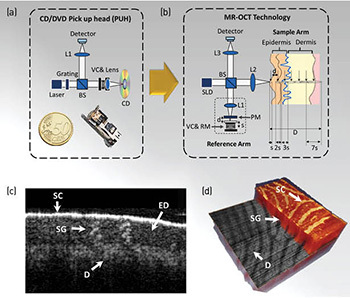 (a) Schematic of the CD/DVD pick-up head module. (b) Converting a CD/DVD pick-up head into a multiple-reference optical coherence tomography (MR-OCT) time-domain OCT platform. SLD, super-luminescent diode; RM, reference mirror; PM, partial mirror; VC, voice coil; L1-L3, lenses; d, distance between RM and PM; r, range of the voice coil; s, round-trip optical delay; D, total imaging range. (c) In vivo MR-OCT B-scan of a human fingertip. (d) Cutaway view of the volume-rendered image showing the structural features. SG, sweat gland; SC, stratum corneum; D, dermis; and ED, epidermis.
(a) Schematic of the CD/DVD pick-up head module. (b) Converting a CD/DVD pick-up head into a multiple-reference optical coherence tomography (MR-OCT) time-domain OCT platform. SLD, super-luminescent diode; RM, reference mirror; PM, partial mirror; VC, voice coil; L1-L3, lenses; d, distance between RM and PM; r, range of the voice coil; s, round-trip optical delay; D, total imaging range. (c) In vivo MR-OCT B-scan of a human fingertip. (d) Cutaway view of the volume-rendered image showing the structural features. SG, sweat gland; SC, stratum corneum; D, dermis; and ED, epidermis.
The application of optical coherence tomography (OCT) in the field of biomedical imaging has increased rapidly in recent years and may continue on this trajectory with growth potential in clinical diagnostics.1 Integration of OCT for affordable point-of-care (POC) diagnostic applications and personal-care monitoring should lead to miniature, inexpensive, portable, robust optical instrumentation that is accurate and simple to use. However, the current embodiments of OCT systems are highly expensive, utilize large-form-factor optical design, and require accurate alignment of complex optics, making them impractical for the POC environment.
In recent years, there has been an increasing interest in the development of a cost-effective, compact and easy-to-use OCT platform for POC diagnostic applications, which can enable rapid and accurate diagnosis and monitoring with reduced cost and time associated with health care services. Multiple-reference OCT (MR-OCT) is a recently developed novel time-domain OCT platform based on a miniature optical delay, which utilizes a single miniature actuator (like a piezoelectric transducer or voice coil or vertical scanning MEMS) and a partial mirror to generate the recirculating optical delay for extended axial-scan range.2,3 Our proposed optomechanical architecture of MR-OCT technology promises to fit into a robust, cost-effective design: the platform can be largely solid-state and can be implemented by the optics and assembly technology used for the production of CD/DVD-ROM pick-up head technology. It costs less than €10 to address a variety of high-volume, depth-resolved sensing, ranging and biometric applications where high speed is not important. We recently published a demonstration of reconstructed cross-sectional images with biological and nonbiological specimens using our prototype MR-OCT platform based on CD/DVD pick-up head technology.
Researchers
Hrebesh M. Subhash,TOMI, NBIPI, National University of Ireland, Galway, and Compact Imaging, Calif., USA
Roshan Dsouza, Martin Leahy and Kai Neuhaus, TOMI, NBIPI, National University of Ireland, Galway
Josh Hogan and Carol Wilson, Compact Imaging, Calif., USA
References
1. A.F. Fercher et al. Rep. Prog. Phys. 66, 239 (2003).
2. H.M. Subhash. Biomedical Optics, OSA Technical Digest, paper BT3A.72 (2014).
3. R. Dsouza et al. Biomed. Opt. Express 5, 2870 (2014).
